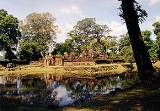
Banteay Srei
Encyclopedia
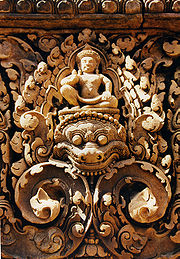
Cambodia
Cambodia , officially known as the Kingdom of Cambodia, is a country located in the southern portion of the Indochina Peninsula in Southeast Asia...
n temple dedicated to the Hindu
Hindu
Hindu refers to an identity associated with the philosophical, religious and cultural systems that are indigenous to the Indian subcontinent. As used in the Constitution of India, the word "Hindu" is also attributed to all persons professing any Indian religion...
god Shiva
Shiva
Shiva is a major Hindu deity, and is the destroyer god or transformer among the Trimurti, the Hindu Trinity of the primary aspects of the divine. God Shiva is a yogi who has notice of everything that happens in the world and is the main aspect of life. Yet one with great power lives a life of a...
. Located in the area of Angkor
Angkor
Angkor is a region of Cambodia that served as the seat of the Khmer Empire, which flourished from approximately the 9th to 15th centuries. The word Angkor is derived from the Sanskrit nagara , meaning "city"...
in Cambodia
Cambodia
Cambodia , officially known as the Kingdom of Cambodia, is a country located in the southern portion of the Indochina Peninsula in Southeast Asia...
. It lies near the hill of Phnom Dei
Phnom Dei
Phnom Dei is a khum of Phnom Srok District in Banteay Meanchey Province in western Cambodia.-Villages:* Phnom Dei* Ponley* Kouk Seh* Thnal Dach* Bos Sbov* Trapeang Prei* Kamping Puoy* Spean Kmeng* Trang* Khchay...
, 25 km (15.5 mi) north-east of the main group of temples that once belonged to the medieval capitals of Yasodharapura
Yasodharapura
Yaśodharapura was the first capital of the Khmer empire to be built at the Angkor site. The city was built during the reign of King Yasovarman I after the palace in the previous capital at Roluos was burned during his struggle to consolidate power upon the death of the previous king, his...
and Angkor Thom
Angkor Thom
Angkor Thom , located in present day Cambodia, was the last and most enduring capital city of the Khmer empire. It was established in the late twelfth century by king Jayavarman VII. It covers an area of 9 km², within which are located several monuments from earlier eras as well as those...
. Banteay Srei is built largely of red sandstone
Sandstone
Sandstone is a sedimentary rock composed mainly of sand-sized minerals or rock grains.Most sandstone is composed of quartz and/or feldspar because these are the most common minerals in the Earth's crust. Like sand, sandstone may be any colour, but the most common colours are tan, brown, yellow,...
, a medium that lends itself to the elaborate decorative wall carvings which are still observable today. The buildings themselves are miniature in scale, unusually so when measured by the standards of Angkorian construction. These factors have made the temple extremely popular with tourists, and have led to its being widely praised as a "precious gem", or the "jewel of Khmer art."
Foundation and dedication
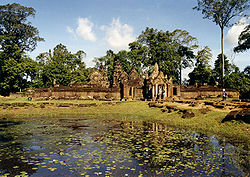
Angkor
Angkor is a region of Cambodia that served as the seat of the Khmer Empire, which flourished from approximately the 9th to 15th centuries. The word Angkor is derived from the Sanskrit nagara , meaning "city"...
not built by a monarch; its construction is credited to a courtier named Yajnavaraha
Yajnavaraha
Yajnavaraha was priest-doctor and a royal physician at the court of king Rajendravarman in Angkor, Cambodia, practising traditional Cambodian medicine and Ayurveda. He was a Brahmin of royal descent and was the grandson of King Harshavarman. Most of his learning was from his father Damodara, who...
/ Yajñavarāha (modern ), who served as a counsellor to king Rājendravarman II
Rajendravarman II
Rajendravarman II was the king of the Khmer Empire , from 944 to 968.Rajendravarman II was a nephew of former king Yasovarman I...
(modern ).The foundational stela says that Yajñavarāha
Yajnavaraha
Yajnavaraha was priest-doctor and a royal physician at the court of king Rajendravarman in Angkor, Cambodia, practising traditional Cambodian medicine and Ayurveda. He was a Brahmin of royal descent and was the grandson of King Harshavarman. Most of his learning was from his father Damodara, who...
, grandson of king Harṣavarman I was a scholar and philanthropist who helped those who suffered from illness, injustice, or poverty. His pupil was the future king Jayavarman V (r. 968- ca. 1001) Originally, the temple was surrounded by a town called Īśvarapura.
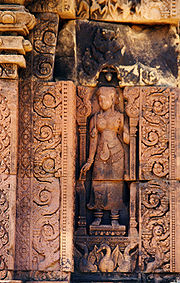
Hindu
Hindu refers to an identity associated with the philosophical, religious and cultural systems that are indigenous to the Indian subcontinent. As used in the Constitution of India, the word "Hindu" is also attributed to all persons professing any Indian religion...
god Śiva
Siva
Siva may refer to:*Shiva, a major Hindu God*Živa , a Slavic goddess*A pro-apoptotic signaling protein*1170 Siva, asteroid named after the god*Siva , name of several rural localities in Russia...
. Originally, it was carried the name Tribhuvanamaheśvara — great lord of the threefold world — in reference to the Shaivite
Siva
Siva may refer to:*Shiva, a major Hindu God*Živa , a Slavic goddess*A pro-apoptotic signaling protein*1170 Siva, asteroid named after the god*Siva , name of several rural localities in Russia...
liṅga that served as its central religious image. However, the temple buildings appear to be divided along the central east-west axis between those buildings located south of the axis, which are devoted to Śiva
Siva
Siva may refer to:*Shiva, a major Hindu God*Živa , a Slavic goddess*A pro-apoptotic signaling protein*1170 Siva, asteroid named after the god*Siva , name of several rural localities in Russia...
, and those north of the axis, which are devoted to Viṣṇu.
The temple's modern name, Bantãy Srĕi — citadel of the women, or citadel of beauty — is probably related to the intricacy of the bas relief carvings found on the walls and the tiny dimensions of the buildings themselves. Some have speculated that it relates to the many devatas carved into the walls of the buildings.
Expansion and rededication
Bantãy Srĕi was subject to further expansion and rebuilding work in the eleventh century. At some point it came under the control of the king and had its original dedication changed; the inscription K 194 from Phnoṃ Sandak, dated Monday, the 14th or 28th of July, 1119 A.D. records (line B 13) the temple being given to the priest Divākarapaṇḍita and being rededicated to Śiva. It remained in use at least until the fourteenth century as the last known inscription K 569), dated Thursday, 8th August 1303 A.D.Restoration
The temple was rediscovered only in 1914, and was the subject of a celebrated case of art theftArt theft
Art theft is usually for the purpose of resale or for ransom . Stolen art is sometimes used by criminals to secure loans.. One must realize that only a small percentage of stolen art is recovered. Estimates range from 5 to 10%. This means that little is known about the scope and characteristics of...
when André Malraux
André Malraux
André Malraux DSO was a French adventurer, award-winning author, and statesman. Having traveled extensively in Indochina and China, Malraux was noted especially for his novel entitled La Condition Humaine , which won the Prix Goncourt...
stole four devatas in 1923 (he was soon arrested and the figures returned). The incident stimulated interest in the site, which was cleared the following year, and in the 1930s Banteay Srei was restored in the first important use of anastylosis
Anastylosis
Anastylosis is an archaeological term for a reconstruction technique whereby a ruined building or monument is restored using the original architectural elements to the greatest degree possible...
at Angkor. Until the discovery of the foundation stela in 1936, it had been assumed that the extreme decoration indicated a later date than was in fact the case. To prevent the site from water damage, the joint Cambodian-Swiss
Switzerland
Switzerland name of one of the Swiss cantons. ; ; ; or ), in its full name the Swiss Confederation , is a federal republic consisting of 26 cantons, with Bern as the seat of the federal authorities. The country is situated in Western Europe,Or Central Europe depending on the definition....
Banteay Srei Conservation Project installed a drainage system between 2000 and 2003. Measures were also taken to prevent damage to the temples walls being caused by nearby trees. Unfortunately, the temple has been ravaged by pilfering and vandalism. When toward the end of the 20th century authorities removed some original statues and replaced them with concrete replicas, looters took to attacking the replicas. A statue of Shiva
Shiva
Shiva is a major Hindu deity, and is the destroyer god or transformer among the Trimurti, the Hindu Trinity of the primary aspects of the divine. God Shiva is a yogi who has notice of everything that happens in the world and is the main aspect of life. Yet one with great power lives a life of a...
and his shakti
Shakti
Shakti from Sanskrit shak - "to be able," meaning sacred force or empowerment, is the primordial cosmic energy and represents the dynamic forces that are thought to move through the entire universe in Hinduism. Shakti is the concept, or personification, of divine feminine creative power, sometimes...
Uma
Parvati
Parvati is a Hindu goddess. Parvati is Shakti, the wife of Shiva and the gentle aspect of Mahadevi, the Great Goddess...
, removed to the National Museum in Phnom Penh
Phnom Penh
Phnom Penh is the capital and largest city of Cambodia. Located on the banks of the Mekong River, Phnom Penh has been the national capital since the French colonized Cambodia, and has grown to become the nation's center of economic and industrial activities, as well as the center of security,...
for safekeeping, was assaulted in the museum itself.
Materials and style
Banteay Srei is built largely of a hard red sandstone that can be carved like wood. BrickBrick
A brick is a block of ceramic material used in masonry construction, usually laid using various kinds of mortar. It has been regarded as one of the longest lasting and strongest building materials used throughout history.-History:...
and laterite
Laterite
Laterites are soil types rich in iron and aluminium, formed in hot and wet tropical areas. Nearly all laterites are rusty-red because of iron oxides. They develop by intensive and long-lasting weathering of the underlying parent rock...
were used only for the enclosure walls and some structural elements. The temple is known for the beauty of its sandstone lintels and pediments.
A pediment
Pediment
A pediment is a classical architectural element consisting of the triangular section found above the horizontal structure , typically supported by columns. The gable end of the pediment is surrounded by the cornice moulding...
is the roughly triangular space above a rectangular doorway or openings. At Banteay Srei, pediments are relatively large in comparison to the openings below, and take a sweeping gabled shape. For the first time in the history of Khmer
Khmer Empire
The Khmer Empire was one of the most powerful empires in Southeast Asia. The empire, which grew out of the former kingdom of Chenla, at times ruled over and/or vassalized parts of modern-day Laos, Thailand, Vietnam, Burma, and Malaysia. Its greatest legacy is Angkor, the site of the capital city...
architecture, whole scenes of mythological subject-matter are depicted on the pediments.
A lintel is a horizontal beam spanning the gap between two posts. Some lintels serve a structural purpose, serving to support the weight of the superstructure, while others are purely decorative in purpose. The lintels at Banteay Srei are beautifully carved, rivalling those of the 9th century Preah Ko
Preah Ko
Preah Ko was the first temple to be built in the ancient and now defunct city of Hariharalaya , some 15 kilometers south-east of the main group of temples at Angkor, Cambodia...
style in quality.
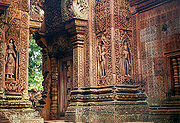
Kala
Kala may refer to:In Hinduism:*Kāla , a Sanskrit word for "time"*Kalā: 64 arts*Kala Bo, a Hindu consort goddess*Kirtimukha: a fierce guardian faceIn culture*Kala , a character in the Tarzan novels*Kala , a 2007 Indonesian film...
(a toothy monster symbolic of time), the guardian dvarapala (an armed protector of the temple) and devata (demi-goddess), the false door, and the colonette. Indeed, decorative carvings seem to cover almost every available surface. According to pioneering Angkor scholar Maurice Glaize
Maurice Glaize
Maurice Glaize was a French architect and archeologist, Conservator of Angkor from 1937 to 1945.-Early years: education, wedding, war and professional experiences:...
, "Given the very particular charm of Banteay Srei — its remarkable state of preservation and the excellence of a near perfect ornamental technique — one should not hesitate, of all the monuments of the Angkor group, to give it the highest priority." At Banteay Srei, wrote Glaize, "the work relates more closely to the art of the goldsmith
Goldsmith
A goldsmith is a metalworker who specializes in working with gold and other precious metals. Since ancient times the techniques of a goldsmith have evolved very little in order to produce items of jewelry of quality standards. In modern times actual goldsmiths are rare...
or to carving in wood
Wood carving
Wood carving is a form of working wood by means of a cutting tool in one hand or a chisel by two hands or with one hand on a chisel and one hand on a mallet, resulting in a wooden figure or figurine, or in the sculptural ornamentation of a wooden object...
than to sculpture
Sculpture
Sculpture is three-dimensional artwork created by shaping or combining hard materials—typically stone such as marble—or metal, glass, or wood. Softer materials can also be used, such as clay, textiles, plastics, polymers and softer metals...
in stone".
The site
The site consists of three concentric rectangular enclosures constructed on an east-west axis. A causeway stituated on the axis leads from an outer gopura, or gate, to the third or outermost of the three enclosures. The inner enclosure contains the sanctuary, consisting of an entrance chamber and three towers, as well as two buildings conventionally referred to as libraries.The outer Gopura
The gopura is all that remains of the outer wall surrounding the town of Isvapura. The wall is believed to have measured approximately 500 m square, and may have been constructed of wood. The gopura's eastern pedimentPediment
A pediment is a classical architectural element consisting of the triangular section found above the horizontal structure , typically supported by columns. The gable end of the pediment is surrounded by the cornice moulding...
shows Indra
Indra
' or is the King of the demi-gods or Devas and Lord of Heaven or Svargaloka in Hindu mythology. He is also the God of War, Storms, and Rainfall.Indra is one of the chief deities in the Rigveda...
, who was associated with that direction, mounted on his three-headed elephant Airavata
Airavata
Airavata is a mythological white elephant who carries the Hindu god Indra. It is also called 'Ardha-Matanga', meaning "elephant of the clouds"; 'Naga-malla', meaning "the fighting elephant"; and 'Arkasodara', meaning "brother of the sun". 'Abharamu' is the elephant wife of Airavata. Airavata has...
. The 67 m causeway with the remains of corridors on either side connects the gopura with the third enclosure. North and south of this causeway are galleries with a north-south orientation.
The Third (Outer) Enclosure

Laterite
Laterites are soil types rich in iron and aluminium, formed in hot and wet tropical areas. Nearly all laterites are rusty-red because of iron oxides. They develop by intensive and long-lasting weathering of the underlying parent rock...
wall breached by gopuras at the eastern and western ends. Neither pediment
Pediment
A pediment is a classical architectural element consisting of the triangular section found above the horizontal structure , typically supported by columns. The gable end of the pediment is surrounded by the cornice moulding...
of the eastern gopura is in situ. The west-facing pediment
Pediment
A pediment is a classical architectural element consisting of the triangular section found above the horizontal structure , typically supported by columns. The gable end of the pediment is surrounded by the cornice moulding...
is now located in the Musée Guimet in Paris. It depicts a scene from the Mahabhārata
Mahabharata
The Mahabharata is one of the two major Sanskrit epics of ancient India and Nepal, the other being the Ramayana. The epic is part of itihasa....
in which the Asura
Asura
-In Hinduism:In Hinduism, the Asuras constitute a group of power-seeking deities, sometimes considered sinful and materialistic. The Daityas and Danavas were combinedly known as Asuras. The Asura were opposed to the Devas. Both groups are children of Kasyapa...
brothers Sunda
Sunda (asura)
A mythological character from the great epic Mahabharata, Sunda was an asura prince and the brother of Upasunda. Their father was Jambha. The brothers grew up to be very powerful and were always of one mind. Together, they embarked on a campaign of world domination that began with a program of...
and Upasunda
Upasunda
A mythological character from the great epic Mahabharata, Upasunda was an asura prince and the brother of Sunda. The brothers grew up to be very powerful and were always of one mind. Together, they embarked on a campaign of world domination that began with a program of extreme asceticism in the...
fight over the Apsaras Tilottamā
Tilottama
Tilottama is an Apsara described in Hindu mythology. "Tila" is the Sanskrit word for sesame seed or a bit and "uttama" means better or higher...
. The east-facing pediment is lying on the ground. It depicts a scene from the Rāmāyaṇa
Ramayana
The Ramayana is an ancient Sanskrit epic. It is ascribed to the Hindu sage Valmiki and forms an important part of the Hindu canon , considered to be itihāsa. The Ramayana is one of the two great epics of India and Nepal, the other being the Mahabharata...
in which a demon seizes Ramā
RAMA
Rama is a first-person adventure game developed and published by Sierra Entertainment in 1996. The game is based on Arthur C. Clarke's books Rendezvous with Rama and Rama II and supports both DOS and Windows 95. It is the second Rama game to be produced...
's wife Sitā
SITA
SITA is a multinational information technology company specialising in providing IT and telecommunication services to the air transport industry...
. Most of the area within the third enclosure is occupied by a moat
Moat
A moat is a deep, broad ditch, either dry or filled with water, that surrounds a castle, other building or town, historically to provide it with a preliminary line of defence. In some places moats evolved into more extensive water defences, including natural or artificial lakes, dams and sluices...
divided into two parts by causeways to the east and west.
The Second Enclosure
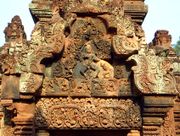
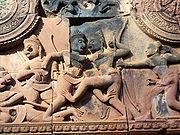
Vali
Vali or Wali can refer to:* Váli * Váli* Vali * The Vali tribe, a Sarmatian tribe of Ptolemy* Ferenc A. Váli, Hungarian-born lawyer, author and political analyst* Al-Walee, one of the Names of God in the Qur'an...
and Sugrīva
Sugriva
In the Hindu epic Ramayana, Sugriva , also spelled Sugreeva or Sugreev, was the younger brother of Bali, whom he succeeded as ruler of the vanara or monkey kingdom Kishkindha. Ruma was his wife. He was the son of Surya, the Hindu deity of the sun...
, as well as Rāma
RAMA
Rama is a first-person adventure game developed and published by Sierra Entertainment in 1996. The game is based on Arthur C. Clarke's books Rendezvous with Rama and Rama II and supports both DOS and Windows 95. It is the second Rama game to be produced...
's intervention on Sugrīva's behalf. The inner enclosure wall has collapsed, leaving a gopura at the eastern end and a brick shrine at the western. The eastern pediment of the gopura shows Śiva Nāṭarāja
Nataraja
Nataraja or Nataraj , The Lord of Dance; Tamil: கூத்தன் ;Telugu:నటరాజ is a depiction of the Hindu god Shiva as the cosmic dancer Koothan who performs his divine dance to destroy a weary universe and make preparations for god Brahma to start the process of creation...
; the west-facing pediment has an image of Durgā
Durga
For the 1985 Hindi Film of Rajesh Khanna see DurgaaIn Hinduism, Durga ; ; meaning "the inaccessible" or "the invincible"; , durga) or Maa Durga "one who can redeem in situations of utmost distress" is a form of Devi, the supremely radiant goddess, depicted as having eighteen arms, riding a lion...
. Likewise, the laterite galleries which once filled the second enclosure (one each to north and south, two each to east and west) have partially collapsed. A pediment on one of the galleries shows the lion-man Narasiṃha
Narasimha
Narasimha or Nrusimha , also spelt as Narasingh and Narasingha, whose name literally translates from Sanskrit as "Man-lion", is an avatar of Vishnu described in the Puranas, Upanishads and other ancient religious texts of Hinduism...
clawing the demon Hiraṇyakaśipu.
The First (Inner) Enclosure
Between the gopuras on the collapsed inner wall are the buildings of the inner enclosure: a library in the south-east corner and another in the north-east corner, and in the centre the sanctuarySanctuary
A sanctuary is any place of safety. They may be categorized into human and non-human .- Religious sanctuary :A religious sanctuary can be a sacred place , or a consecrated area of a church or temple around its tabernacle or altar.- Sanctuary as a sacred place :#Sanctuary as a sacred place:#:In...
set on a T-shaped platform 0.9 m high. Besides being the most extravagantly decorated parts of the temple, these have also been the most successfully restored (helped by the durability of their sandstone and their small scale). In 2010, the first enclosure is open to visitors again, but the inner temples are roped off and inaccessible.
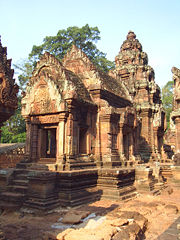
The Libraries
The two libraries are of brick, laterite and sandstone. Each library has two pedimentPediment
A pediment is a classical architectural element consisting of the triangular section found above the horizontal structure , typically supported by columns. The gable end of the pediment is surrounded by the cornice moulding...
s, one on the eastern side and one on the western. According to Maurice Glaize, the four library pediments, "representing the first appearance of tympanum
Tympanum (architecture)
In architecture, a tympanum is the semi-circular or triangular decorative wall surface over an entrance, bounded by a lintel and arch. It often contains sculpture or other imagery or ornaments. Most architectural styles include this element....
s with scenes, are works of the highest order. Superior in composition to any which followed, they show true craftsmanship in their modelling in a skilful blend of stylisation and realism."
- The east-facing pediment on the southern library shows ŚivaSivaSiva may refer to:*Shiva, a major Hindu God*Živa , a Slavic goddess*A pro-apoptotic signaling protein*1170 Siva, asteroid named after the god*Siva , name of several rural localities in Russia...
seated on the summit of Mount KailāsaMount KailashMount Kailash is a peak in the Gangdisê Mountains, which are part of the Himalayas in Tibet...
, his mythological abode. His consort UmāParvatiParvati is a Hindu goddess. Parvati is Shakti, the wife of Shiva and the gentle aspect of Mahadevi, the Great Goddess...
sits on his lap and clings anxiously to his torso. Other beings are also present on the slopes of the mountain, arranged in a strict hierarchy of three tiers from top to bottom. In the top tier sit bearded wise men and ascetics, in the middle tier mythological figures with the heads of animals and the bodies of humans, and in the bottom tier large animals, including a number of lions. In the middle of the scene stands the ten-headed demon king RāvaṇaRavana' is the primary antagonist character of the Hindu legend, the Ramayana; who is the great king of Lanka. In the classic text, he is mainly depicted negatively, kidnapping Rama's wife Sita, to claim vengeance on Rama and his brother Lakshmana for having cut off the nose of his sister...
. He is shaking the mountain in its very foundations as the animals flee from his presence and as the wise men and mythological beings discuss the situation or pray. According to the legend, Śiva stopped Rāvaṇa from shaking the mountain by using his toe to press down on the mountain and to trap Rāvana underneath for 1000 years. - The west-facing pedimentPedimentA pediment is a classical architectural element consisting of the triangular section found above the horizontal structure , typically supported by columns. The gable end of the pediment is surrounded by the cornice moulding...
on southern library shows ŚivaSivaSiva may refer to:*Shiva, a major Hindu God*Živa , a Slavic goddess*A pro-apoptotic signaling protein*1170 Siva, asteroid named after the god*Siva , name of several rural localities in Russia...
again seated on the summit of Mount KailāsaMount KailashMount Kailash is a peak in the Gangdisê Mountains, which are part of the Himalayas in Tibet...
. He is looking to his left at the god of love KāmaKamaKāma is often translated from Sanskrit as sexual desire, sexual pleasure, sensual gratification, sexual fulfillment, or eros54654564+more broadly mean desire, wish, passion, longing, pleasure of the senses, the aesthetic enjoyment of life, affection, or love, without sexual connotations.-Kama in...
, who is aiming an arrow at him. UmāParvatiParvati is a Hindu goddess. Parvati is Shakti, the wife of Shiva and the gentle aspect of Mahadevi, the Great Goddess...
sits to Śiva's right; he is handing her a chain of beads. The slopes of the mountain are crowded with other beings, again arranged in a strict hierarchy from top to bottom. Just under Śiva sit a group of bearded wise men and ascetics, under whom the second tier is occupied by the mythological beings with the heads of animals and the bodies of humans; the lowest tier belongs the common people, who mingle sociably with tame deer and a large gentle bull. According to the legend, Kāma fired an arrow at Śiva in order to cause Śiva to take an interest in Umā. Śiva, however, was greatly angered by this provocation, and punished Kāma by gazing upon him with his third eye, frying Kāma to cinders.
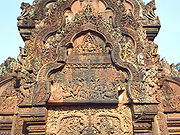
- The east-facing pediment on the northern library shows the god of the sky IndraIndra' or is the King of the demi-gods or Devas and Lord of Heaven or Svargaloka in Hindu mythology. He is also the God of War, Storms, and Rainfall.Indra is one of the chief deities in the Rigveda...
creating rain to put out a forest fire started by the god of fire AgniAgniAgni is a Hindu deity, one of the most important of the Vedic gods. He is the god of fire and the acceptor of sacrifices. The sacrifices made to Agni go to the deities because Agni is a messenger from and to the other gods...
for purposes of killing the nāgaNagaNaga or NAGA may refer to:* Nāga, a group of serpent deities in Hindu and Buddhist mythology.-People:* Nayan / Nayar/Nair people of Kerala Society* Naga people, a diverse ethnic identity in Northeast India...
king Takṣaka who lived in Khāṇḍava ForestKhandava ForestKhandava Forest was an ancient forest mentioned in the epic Mahabharata. It lay to the west of Yamuna river, in modern day Delhi territory. Pandavas cleared this forest to construct their capital city called Indraprastha. This forest was earlier inhabited by Naga tribes led by a king named Takshaka...
. The MahābhārataMahabharataThe Mahabharata is one of the two major Sanskrit epics of ancient India and Nepal, the other being the Ramayana. The epic is part of itihasa....
n heroes Kṛṣṇa and ArjunaArjunaArjuna in Indian mythology is the greatest warrior on earth and is one of the Pandavas, the heroes of the Hindu epic Mahābhārata. Arjuna, whose name means 'bright', 'shining', 'white' or 'silver' Arjuna (Devanagari: अर्जुन, Thai: อรชุน, Orachun, Tamil: Arjunan, Indonesian and Javanese: Harjuna,...
are shown helping Agni by firing a dense hail of arrows to block Indra's rain. Takṣaka's son Aśvasena is depicted attempting to escape from the conflagration, while other animals stampede about in panic. - The west-facing pediment on the southern library depicts Kṛṣṇa slaying his wicked uncle KaṃsaKamsaIn Hinduism, Kamsa or Kansa , often known as Kans in Hindi, is the brother of Devaki, and ruler of the Vrishni kingdom with its capital at Mathura. His father was King Ugrasena and mother was Queen Padmavati...
.
The Sanctuary
The sanctuary is entered from the east by a doorway only 1.08 m in height: inside is an entrance chamber (or maṇḍapaMandapa
A mandapa in Indian architecture is a pillared outdoor hall or pavilion for public rituals.-Temple architecture:...
) with a corbelled brick roof, then a short corridor leading to three towers to the west: the central tower is the tallest, at 9.8 m. Glaize notes the impression of delicacy given the towers by the antefixes on each of their tiers. The six stairways leading up to the platform were each guarded by two kneeling statues of human figures with animal heads; most of those now in place are replicas, the originals having been stolen or removed to museums.
External links
- APSARA Authority. Banteay Srei
- Banteay Srei Photo Gallery

